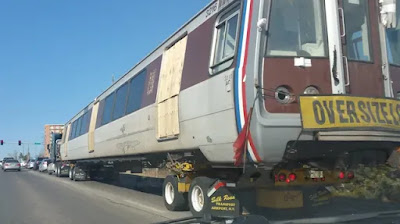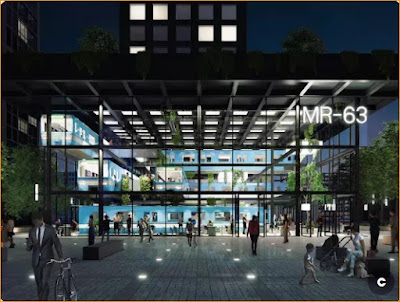The world over cities are rediscovering their rivers. Historic Frederick, MD successfully looked at San Antonio, TX when it created its own Riverwalk, an all around successful project bearing fruit for years now. Denver, CO is taking advantage of its rather puny Platte River to the fullest extent in ever new segments that boast riverfront trails and redevelopment of former industrial sites in RiNo.
 |
| Adaptive reuse and Platte River greenway in Denver's Ri-No district. (Photo:Philipsen) |
But in Baltimore we have done almost nothing to celebrate our Jones Falls in spite of its beauty that is far exceeding the creeks of the examples. Not only did we leave it lingering underground over wide stretches, we are seriously discussing placing a recycling transfer station along its banks in a spot where it is about the most beautiful.
The renewed discussions about the Sisson Street recycling transfer station and the possible relocation to the adjacent but much lower Potts and Callahan site motivated me to walk Sisson Street from 29th Street to 26 Street and the closed Sisson Street bridge and I saw only opportunities. Most of us know this area only from flying over the bridges of 28th and 29th Streets, high above the river and crossing Sisson Street at the edge of Remington. And what an edge it is! The landscape urbanist Alan Berger coined the term Drosscape for these urban wastelands which are vestiges of a time long passed in which the river attracted all kinds of industries. Today this edge consists of abandoned and repurposed factories, billboards, communication towers, a gas station, a fast food place, two bus facilities and acres of unused pavement. And a waste stations.
This low-intensity-use landscape is so underutilized that it should invite any creative mind to imagine what it could be. Cues of possibilities are everywhere, in the vegetation surround some abandoned structures, the driveways that gently overcome the significant drop between Sisson Street and Falls Road and in the architecture of some of the old industrial buildings.
 |
| The Sisson transfer station (partial view) (Photo: Philipsen |
Denver's redevelopment of the River-North arts district (RiNo) comes to mind in which the River Platte plays a major role. Those transformation do not come without intention and major efforts. THK designed South Platte river greenway masterplan and Sasaki created the Denargo district masterplan. Plans to turn the Platte from a stinking backwater into an urban attraction have been in the works for decades. Today Denver developed some 60 miles of river trails with additional projects still underway or to be started. Today Denver's economic vitality is in large parts based on active recreation along its riverbanks.
In Baltimore the lift would be much easier. Remington has already come a long way from a disinvested area to a desired location to live, populated by folks of various incomes, races and orientations. What is needed is to connect this neighborhood to a cleaned up the Jones Falls river greenway. Such a link would create a beautiful synergy and many opportunities for innovative re-use of those drosscape spaces.
 |
| Part of the Sisson Street "Drosscape" in the area where Remington could connect to the Jones Falls (Photo Philipsen) |
The recycling transfer station plays a pivotal role. It occupies over 5 acres used for dropping off recyclables from private vehicles, placing a number of dumpsters with sorted materials and truck access to and from the dumpsters. The site was declared surplus and even offered in a proposal process by BDC. The interested party in the site is Seawall Development, the same developer responsible for a lot of reinvestment in Remington. They want to build a commercial development with a grocery store on the site. The City proposed to relocate the facility to the adjacent lot where the streetcar museum wants to refurbish the old railroad roundhouse to house their museum there.
A re-imagined transfer station that would be incorporated into a mixed use development could be innovative and feature green roofs etc., in short be made compatible with the efforts to connect Remington to the Jones Falls. An example of such an approach can be found in Seattle.
The success of this trash-processing station in a residential neighborhood shows that with a thoughtful discovery process, design can make even the most noxious building typology a boon.
Seattle’s North Transfer Station might reasonably be mistaken as a factory for electric cars or some other high-tech production facility. But the low-lying translucent glass and concrete structure actually houses a dump, right between two residential neighborhoods and less than 100 yards from the shore of Lake Union. (Architecture Magazine)
For now the Mayor put the dumpster site plans on hold by announcing that he will form a task force to look into all options for the Sisson facility. The task force will include City Council members, community stakeholders and city officials. Scott promised to "consider all options for the future of the transfer station, including keeping it where it is, moving it or simply closing it”.
 |
| Scenic portions of the Jones Falls along Falls Road make you feel like you are far outside the city |
Meanwhile the Friends of the Jones Falls have received a grant to create a strategic plan for the future of the Jones Falls and its connected waterways. The project is touted as a historic collaboration between City and County from Greenspring Valley to the Inner Harbor. The work will be led by three team leaders for the upper, middle and lower portion of the stream.
Efforts of making the Jones Falls a central feature of Baltimore's planning infrastructure are not new. The Olmsted Brothers did as much in their 1904 Report Upon the Development of Public Grounds for Greater Baltimore, but that was obviously before the JFX was built above much of the stream. Currently there is also a Jones Falls Gateway Masterplan and a Gateway project which "seeks to transform a narrow, discontinuous sidewalk along the south side of Falls Road and Lanvale Street — between the CSX Bridge underpass (next to the Streetcar Museum) and Charles Street — into a 10–13' wide shared-use path suitable for people of all ages." Finally, the City has its own Green Network Plan which also makes the Jones Falls part of a larger trail network.
 |
| The Potts and Callahan site with the roundhouse desired by the Streetcar Museum which already loops its tracks through the site (Photo: Philipsen) |
In short, there is enough awareness of the importance of the Jones Falls for recreation and green networks that any attempt of putting a trash station at its banks appears as planning blasphemy, or at least as something where the left hand doesn't know what the right hand is doing, the affliction of not seeing the forest for the trees that seems to be all too common in Baltimore. For once, please see the bigger picture!
Klaus Philipsen, FAIA
 |
| Drosscape: Underutilized but with potential: The areas along the edge of Remington |
 |
| Underutilized, partly green: Opportunities to connect to the river |
 |
| The transfer site sits on a large retaining wall |
 |
| Transfer site used by citizens driving up their recyclables |
 |
| Sisson Street community park |
 |
| Remington's edge: Gas stations, fast food, factories |
 |
| Active uses in old factories can be incorporated in a greenway connection plan as they are in Denver's Ri-No |

























